Signalman Arnold Osmond Topliff BEM
Arnie Topliff was one of only two men to earn a gallantry award in the aftermath of the sinking of the prisoner of war transport SS Lisbon Maru in October 1942. His award of the British Empire Medal was one of 56 to Royal Signals soldiers during the Second World War for acts of gallantry.

Signalman Arnie Topliff BEM
The eldest of two sons and two daughters, he was born in Derby on 9 March 1919. He started school there before the family moved to a small-holding in Quarndon.[1] Arnie was a keen sportsman, representing the village at cricket and football, and a strong swimmer. He was also a chorister in the parish church, St Paul’s. His father had served with the Royal Navy before, during and after the First World War, initially on battleships and later as a submariner[2] and after the war he joined Derby Corporation Electrical Department. When he left school, Arnie Topliff also joined the Derby Corporation, as an electrical cable joiner. It was natural, therefore, that when he enlisted on 6 December 1939 and joined Royal Signals he became a lineman. During his training early in 1940 Arnold Topliff married Nellie Moseley. After his training he was posted to the Far East, to the Hong Kong Signal Company.
On 8 December 1941, the Japanese attacked Hong Kong. After 17 days of hard fighting the garrison surrendered; approximately 11,000 men went into captivity on or near the island. In late-September 1942, over 1,800 men were moved aboard the cargo ship SS Lisbon Maru destined for labour camps in Japan. On 1 October, in the East China Sea the Lisbon Maru was hit by a torpedo fired by the United States submarine USS Grouper; she sank the next day. In the course of the aftermath, Arnie Topliff rescued an officer of the Middlesex Regiment in most gruelling circumstances—the story of the Hong Kong Signal Company and the Lisbon Maru may be read here.
The survivors from the Lisbon Maru were shipped first to a camp near Shanghai and then on the Shinsei Maru to Osaka in Japan. ‘Topper’ Topliff, as he became known, spent most of his captivity at Osaka Main Camp No. 1B. The camp, called ‘Honjo’ or ‘Chikko’ and known by many of the prisoners as ‘Hoincho’, was established in September 1942 with the arrival of 150 men from another camp. On 11 October, around 500 survivors of the Lisbon Maru arrived. The camp was established to provide a workforce of stevedores for the commercial transportation companies using the nearby port. A detailed description of the camp and the role of the prisoners may be found in the report for the Supreme Commander Allied Powers written in February 1946.
In May 1945, Topliff was amongst a group from Osaka transferred to the small branch camp Notogawa (Camp No. 9B), which was on the shore of Lake Biwa near Notogawa Station in Shiga Prefecture, about 30 miles north-east of Kyoto. Here the prisoners—Americans, Australians, British and Dutch—were engaged in dike and canal construction to create rice fields. As had been the case at Osaka, conditions were harsh, the food was poor, and the two barracks were over-crowded.
The camp was abandoned by the Japanese guards just after the end of the war. During the planning for the Allied occupation of Japan—Operation Blacklist—work had been undertaken to locate where prisoners of war and civilian internees were being held and to plan a series of airdrops to provide them with food and essential equipment, prior to their recovery and repatriation. By the end of September 1945 almost all the 32,000 prisoners in Japan were on their way home. Most of the British and Australian prisoners were taken to Australia and Arnie Topliff arrived in Melbourne in mid-September. One of the first things that he did was to telegram his parents to let them know that he was safe.
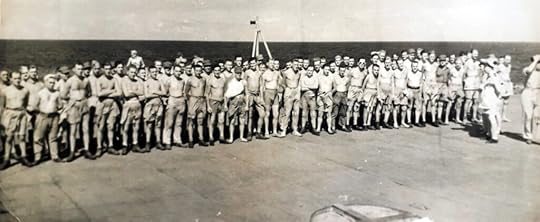
The repatriation of Arnold Topliff and others to Australia, September 1945
Signalman Topliff’s BEM was announced in the London Gazette in March 1946. He was demobilised on 1 May that year and returned home to Quarndon. His medal was sent to him in the post (a common practice) in April 1947. His other medals for his war service were the 1939-45 Star, Pacific Star, British War Medal 1939-45, and Defence Medal. He went to work with the East Midlands Electricity Board, where he became a mains foreman, and he was a regular attendee at Royal Signals and Prisoners of War reunions. His marriage to Nellie did not last and the couple were divorced in June 1947. More happily, in early 1951 Arnold Topliff married Evelyn Sturgess and the couple had a son, Ian, born in 1957.[3] Tragically, Arnold Topliff BEM died suddenly of a heart attack on 24 December 1969, aged only 50. Typically of the man, he had been into work only hours before to check on ‘his blokes’ in Derby who were working on an electricity breakdown in the town and were struggling to reconnect the power in time for Christmas Day. He was buried at St Pauls’ Church, Quarndon. Evelyn died in 1982.

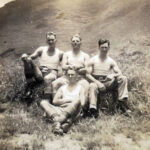
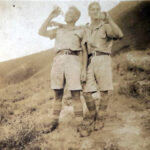
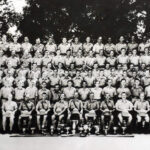

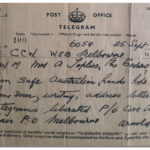
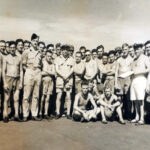
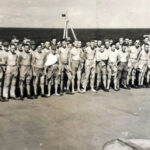
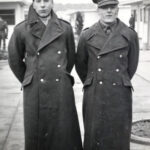
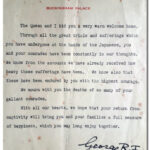
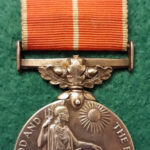
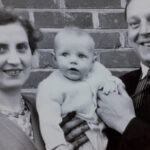
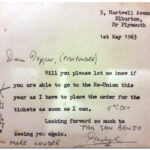 here, reel three, at 14.55). The sign-off ‘tak san benjo’ translates roughly (in prisoner vernacular) as ‘a lot of crap’.
here, reel three, at 14.55). The sign-off ‘tak san benjo’ translates roughly (in prisoner vernacular) as ‘a lot of crap’.Photo: Topliff family.
" data-image-caption="Reunion letter from fellow prisoner George Bainborough, May 1963
" data-medium-file="https://www.nickmetcalfe.co.uk/wp-con..." data-large-file="https://www.nickmetcalfe.co.uk/wp-con..." />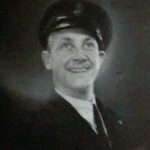 here.
here.Photo: Topliff family.
" data-image-caption="George Harry Bainborough, Royal Navy
" data-medium-file="https://www.nickmetcalfe.co.uk/wp-con..." data-large-file="https://www.nickmetcalfe.co.uk/wp-con..." />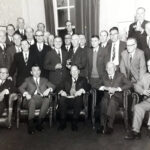

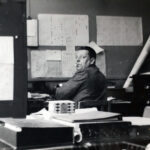
1. (Back) Ernest Osmond Topliff (18 June 1895-October 1970) married Annie Elizabeth Lynch (13 September 1894-September 1972) at Holy Trinity Church, Derby on 11 February 1917. Both are buried at St Pauls’ Church, Quarndon. The couple had another son who died in infancy.
2. (Back) After serving on the battleships HMS Renown, HMS Revenge (both pre-war) and HMS Dreadnought, Able Seaman Topliff (a 1st Class Stoker) retrained as a submariner in 1916 and served on the submarine C-13. He was based in various submarine service depot ships in the war (HMS Dolphin, HMS Bonaventure, and HMS Titania) and at the end of the war was posted to the minesweeper HMS Hebe. He joined the submarine K-22 on 4 February 1919, and then submarine H-23 in September 1922, which was his last boat. He was rated as a Leading Stoker in 1923, posted ashore in April 1924 and transferred to the Royal Fleet Reserve in August 1924. He was awarded the Royal Fleet Reserve Long Service Medal in 1928 to add to his 1914-15 Star, British War Medal 1914-20, and Victory Medal.
3. (Back) Mary Evelyn Sturgess (2 February 1925-26 January 1982).



